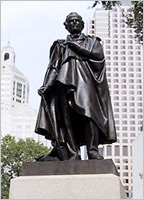 Near the pond, in the east section of Bushnell Park, stands a magnificent statue of a capped gentleman, holding a cane, and silently gazing out over the green landscape. To many, simply another sculpture of a famous person of days long gone by. But, this is a statue of Horace Wells, and his contribution to the world is an interesting tale.
Near the pond, in the east section of Bushnell Park, stands a magnificent statue of a capped gentleman, holding a cane, and silently gazing out over the green landscape. To many, simply another sculpture of a famous person of days long gone by. But, this is a statue of Horace Wells, and his contribution to the world is an interesting tale.
Wells was born in Hartford, Vermont, at the turn of the nineteenth century. A life-long city resident, he was a dentist whose discovery of anesthesia banished surgical pain, revolutionized surgery, and brought safety and comfort to the operating room. Apprenticed to some of the best dentists in Boston (there were no schools of dentistry back then), Wells returned home after his training to open his own practice on Main Street.
Over a short period, Wells became known as the best dentist in Hartford — an area that was known for excellent dentistry. He championed the slogan, “the clean tooth does not decay!” which was used into the twentieth century to encourage children to clean their teeth. Because of his creativity, Wells even designed his own instruments and discovered dental procedures to aid in these methods.
In the 1840’s, various lectures were given in Hartford on the effects of nitrous oxide gas, known as laughing gas.
These lectures demonstrated the euphoric effects of nitrous oxide on people. Wells theorized that this gas could be used for surgical procedures. Up to that point, surgery was very painful to the patient, forcing surgeons to hurry through the procedure, thereby not allowing for quality care. Previously, methods to combat pain included alcohol, opium, and even hypnotism . Wells claimed that a patient could be gassed with nitrous oxide, feel no pain during the procedure, and awake feeling little, if any, discomfort.
Confident in his theory, Wells experimented with the gas on himself and on November 1, 1844, having inhaled the gas, had an associate extract one of his teeth. After the effects of the gas had worn off, Wells exclaimed, “I did not feel so much as the prick of a pin. A new era in tooth-pulling has come!” Wells continued experimenting with “laughing gas”as well as ether. Unfortunately, these experiments affected his brain and ultimately brought about his demise on January 24, 1848. Today, Wells’ grave can be found in the Cedar Hill Cemetery in Hartford.
Honored by the American Dental Association, The Medical Society of New York, the Connecticut State Assembly and the State Dental Commission, the State and City jointly commissioned a bronze sculpture of Wells by T. H. Bartlett in 1874. One particular group of Connecticut dentists, the Horace Wells Club, formed in 1894 on the fiftieth anniversary of Wells’ great discovery, meets every year on the anniversary of Wells’ discovery, to remember this great benefactor and to foster the study of anesthesiology.
Special thanks to David L. Logsdon
